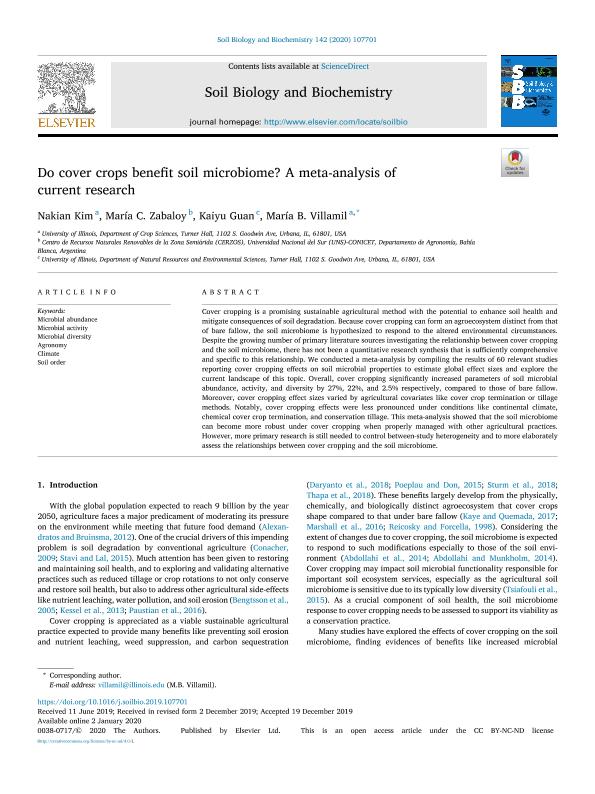Mostrar el registro sencillo del ítem
dc.contributor.author
Kim, Nakian
dc.contributor.author
Zabaloy, Maria Celina

dc.contributor.author
Guan, Kaiyu
dc.contributor.author
Villamil, Maria Bonita

dc.date.available
2020-06-08T00:05:14Z
dc.date.issued
2020-03
dc.identifier.citation
Kim, Nakian; Zabaloy, Maria Celina; Guan, Kaiyu; Villamil, Maria Bonita; Do cover crops benefit soil microbiome? A meta-analysis of current research; Pergamon-Elsevier Science Ltd; Soil Biology And Biochemistry; 142; 3-2020; 107701
dc.identifier.issn
0038-0717
dc.identifier.uri
http://hdl.handle.net/11336/106817
dc.description.abstract
Cover cropping is a promising sustainable agricultural method with the potential to enhance soil health and mitigate consequences of soil degradation. Because cover cropping can form an agroecosystem distinct from that of bare fallow, the soil microbiome is hypothesized to respond to the altered environmental circumstances. Despite the growing number of primary literature sources investigating the relationship between cover cropping and the soil microbiome, there has not been a quantitative research synthesis that is sufficiently comprehensive and specific to this relationship. We conducted a meta-analysis by compiling the results of 60 relevant studies reporting cover cropping effects on soil microbial properties to estimate global effect sizes and explore the current landscape of this topic. Overall, cover cropping significantly increased parameters of soil microbial abundance, activity, and diversity by 27%, 22%, and 2.5% respectively, compared to those of bare fallow. Moreover, cover cropping effect sizes varied by agricultural covariates like cover crop termination or tillage methods. Notably, cover cropping effects were less pronounced under conditions like continental climate, chemical cover crop termination, and conservation tillage. This meta-analysis showed that the soil microbiome can become more robust under cover cropping when properly managed with other agricultural practices. However, more primary research is still needed to control between-study heterogeneity and to more elaborately assess the relationships between cover cropping and the soil microbiome.
dc.format
application/pdf
dc.language.iso
eng
dc.publisher
Pergamon-Elsevier Science Ltd

dc.rights
info:eu-repo/semantics/openAccess
dc.rights.uri
https://creativecommons.org/licenses/by-nc-nd/2.5/ar/
dc.subject
AGRONOMY
dc.subject
CLIMATE
dc.subject
MICROBIAL ABUNDANCE
dc.subject
MICROBIAL ACTIVITY
dc.subject
MICROBIAL DIVERSITY
dc.subject
SOIL ORDER
dc.subject.classification
Ciencias del Suelo

dc.subject.classification
Agricultura, Silvicultura y Pesca

dc.subject.classification
CIENCIAS AGRÍCOLAS

dc.title
Do cover crops benefit soil microbiome? A meta-analysis of current research
dc.type
info:eu-repo/semantics/article
dc.type
info:ar-repo/semantics/artículo
dc.type
info:eu-repo/semantics/publishedVersion
dc.date.updated
2020-05-27T16:31:36Z
dc.journal.volume
142
dc.journal.pagination
107701
dc.journal.pais
Países Bajos

dc.journal.ciudad
Amsterdam
dc.description.fil
Fil: Kim, Nakian. University of Illinois at Urbana; Estados Unidos
dc.description.fil
Fil: Zabaloy, Maria Celina. Consejo Nacional de Investigaciones Científicas y Técnicas. Centro Científico Tecnológico Conicet - Bahía Blanca. Centro de Recursos Naturales Renovables de la Zona Semiárida. Universidad Nacional del Sur. Centro de Recursos Naturales Renovables de la Zona Semiárida; Argentina. Universidad Nacional del Sur. Departamento de Agronomía; Argentina
dc.description.fil
Fil: Guan, Kaiyu. University of Illinois at Urbana; Estados Unidos
dc.description.fil
Fil: Villamil, Maria Bonita. University of Illinois at Urbana; Estados Unidos. Consejo Nacional de Investigaciones Científicas y Técnicas; Argentina
dc.journal.title
Soil Biology And Biochemistry

dc.relation.alternativeid
info:eu-repo/semantics/altIdentifier/url/https://www.sciencedirect.com/science/article/pii/S0038071719303657
dc.relation.alternativeid
info:eu-repo/semantics/altIdentifier/doi/http://dx.doi.org/10.1016/j.soilbio.2019.107701
Archivos asociados
